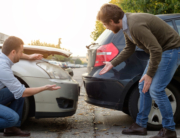 Most people do not put a lot of thought into driving with their pets in the car. In fact, many drivers do not think twice about having their furry friend ride in their lap, head out the window. Unfortunately, though, allowing your pets to roam your car unrestrained puts both you and your pet at risk. Pets cause distractions, and distractions cause accidents. For a safe and uneventful trip, try these tips for traveling with pets in the car:
Most people do not put a lot of thought into driving with their pets in the car. In fact, many drivers do not think twice about having their furry friend ride in their lap, head out the window. Unfortunately, though, allowing your pets to roam your car unrestrained puts both you and your pet at risk. Pets cause distractions, and distractions cause accidents. For a safe and uneventful trip, try these tips for traveling with pets in the car:
Always Restrain Your Pets
Less than 20 percent of pet owners who take their dogs along on rides use restraints to secure their pet, according to a survey by the American Automobile Association (AAA).
The rest of the family buckles up, so Spot should, too! The best options include a small carrier for small dogs or cats, a larger crate for medium to large dogs, a barrier designed for SUVs, or a specially designed harness and clip that connect to a regular seat belt or LATCH system.
By restraining your pets, you help protect them in the event of an accident. Unrestrained pets may also strike other passengers in the car in the event of a crash, causing injuries.
Remain Focused on the Road
You probably understand the risks associated with other types of distracted driving, but did you know that driving with your pet in the car can be just as dangerous as other distracting behaviors?
Many people who have otherwise good driving habits find themselves taking their eyes off the road when their pets are in the car. According to AAA, 65 percent of owners have engaged in at least one distracting behavior with their pets behind the wheel.
Perhaps even more shockingly is what these drivers do while driving — petting, feeding and playing with their furry friends were all common responses on the survey.
Of course, pets can get into trouble all on their own. A dog or cat who is misbehaving is also a serious distraction for a driver. Restraining your pets to keep them safe also limits their ability to act up, allowing you to keep your eyes on the road ahead.
Keep Fido in the Back Seat
AAA reports that 17 percent of drivers allow their pets to ride in their lap. While this is an obvious issue if you have a 150-pound mastiff, many do not think twice about a six-pound Pomeranian. No matter the size, however, it is better for your pet to be in the back seat. When animals ride in the front seat, drivers are more tempted to pet or play with their pet.
Pets are also safer in the back seat. Even the largest dogs can suffer injuries or die from the impact of a deploying airbag in an otherwise minor accident. The safest place for pets is away from the airbags, restrained in the back seat.
Keep All Noses Inside the Car
Dogs love to feel the wind on their faces, and we love to see happy pups hanging their heads out of car windows driving down the road. In reality, though, this is never a good idea. You should never allow your pet to stick his head out the window, because there is a serious risk of injury in doing so. Road debris could strike him, or the wind could irritate his eyes and mucous membranes.
In addition, large dogs can block your view. This makes it difficult to check your blind spots, and to remain aware of other motorists around you.
Strap Down the Crate
Putting your pet in a carrier or crate does little good if you do not secure the crate. If you do not strap down the crate, your pet may suffer injuries if you have to slam on your brakes, causing the carrier to fly around the car. The crate can also turn over, slide, or shift as the animal moves unless you secure it properly.
With smaller carriers, you can often use the car’s seat belt to secure them. Crates in the rear cargo area of an SUV or van are typically securable with tethers. Some crates even come with an option to connect to your vehicle’s LATCH system just like a child’s car seat.
Secure Your Pet Before Opening the Door
Even pets that do not have a tendency to run often might take off when they are in unusual circumstances. An accident, an unexpected stop, or simply a long road trip may be enough to confuse your furry friend and send them running the moment you open the door.
For this reason, it is important to always have your pet secured before opening the door. Leash dogs or ensure cats are in a secure carrier before exiting your vehicle. Pets that escape can get lost, run into traffic and get hurt, or cause an accident.
Be Ready for an Emergency
While you never want to encounter a situation where you become separated from your pet, it pays to ensure you are ready in case it happens. In case of this type of emergency:
- Never leave home without a collar and ID tags on your pet
- Make sure all of the contact information is current
- Invest in new ID tags if your cell phone number is not included — if someone finds your pet while you are away from home, s/he will need a way to contact you
- Update your pet’s microchip registration and contact information if necessary
- Carry a recent picture of your pet
Always Carry Vaccination Records
If there is ever any incident involving your pet and another animal or a person, one of the first things you will need is vaccination records. Carrying these records, along with recent medical records, is a good idea if you are traveling more than a few minutes from home. These records are also vital in ensuring your pet gets the proper treatment if he suffers injuries or becomes ill while you are traveling.
About Montero Law Center
If you and your pet suffer injuries in a Fort Lauderdale car accident, Montero Law Center can help you get the money you need to cover your losses. We can also help you determine if the insurance company will cover your pet’s vet bills, in addition to your other accident-related expenses.
Call us today at 954-767-6500 to schedule an appointment to discuss your case with one of our Fort Lauderdale attorneys.
 English
English  Español
Español 




